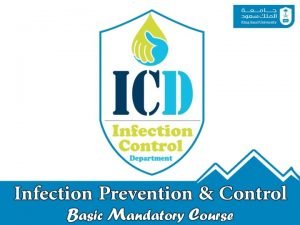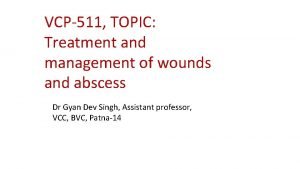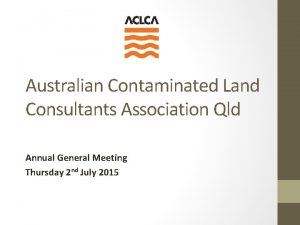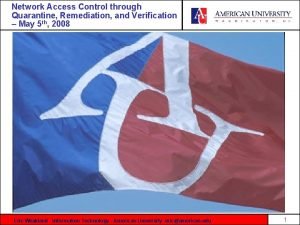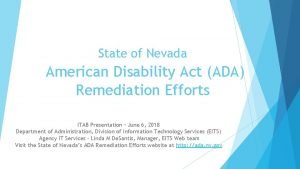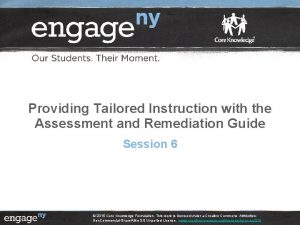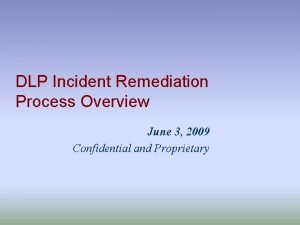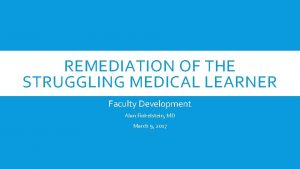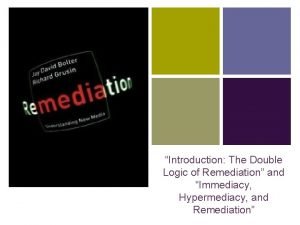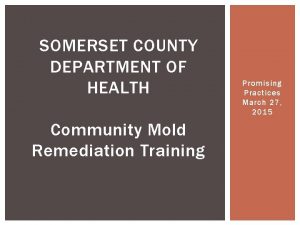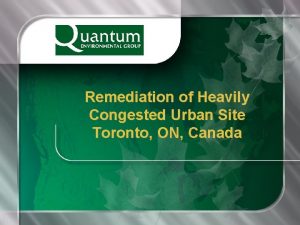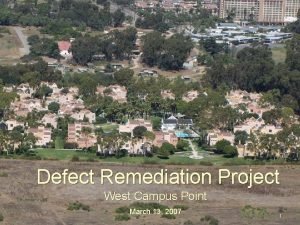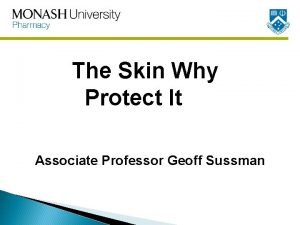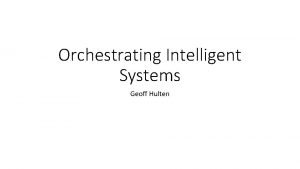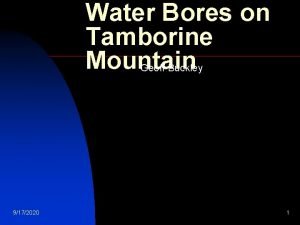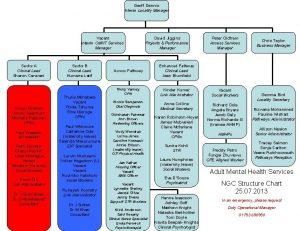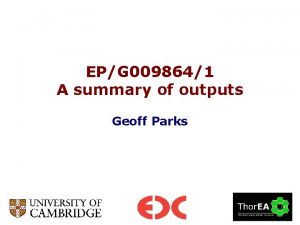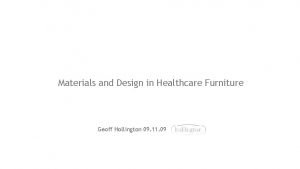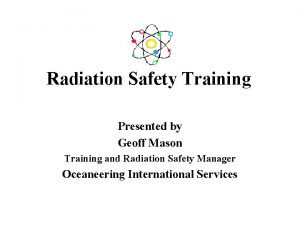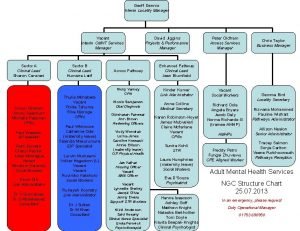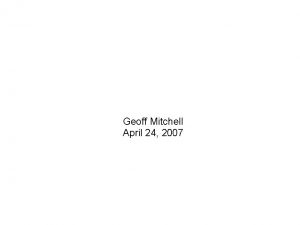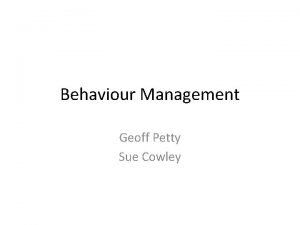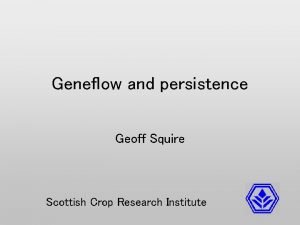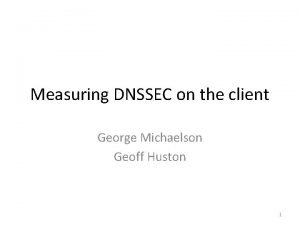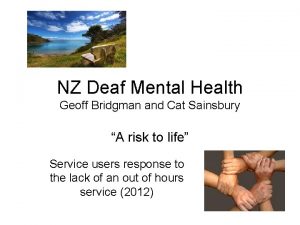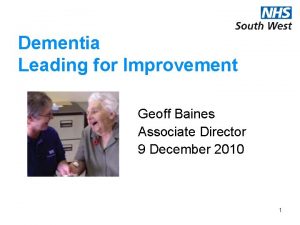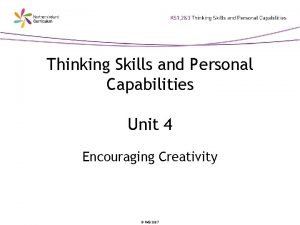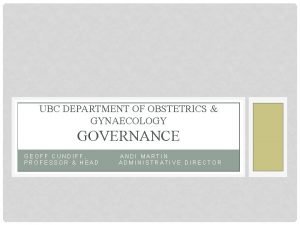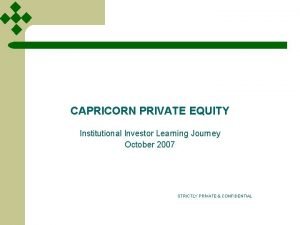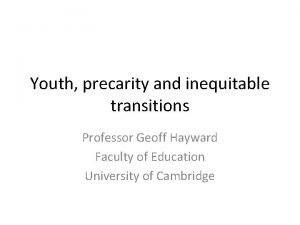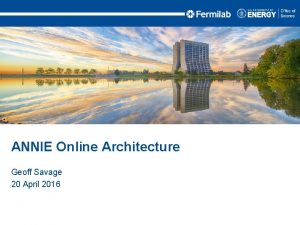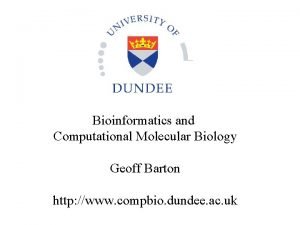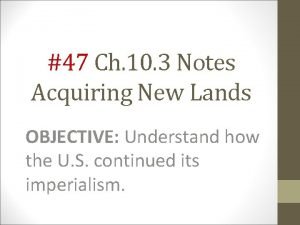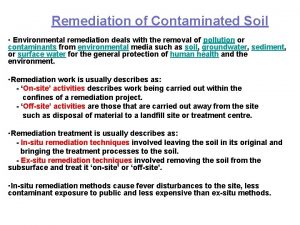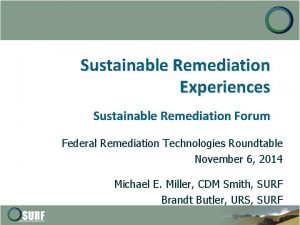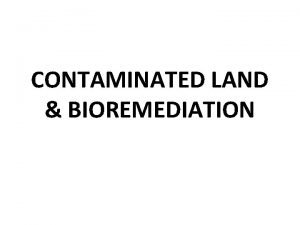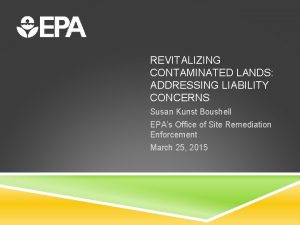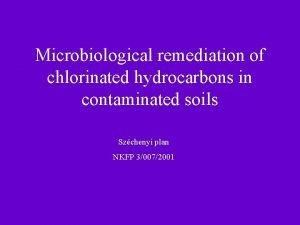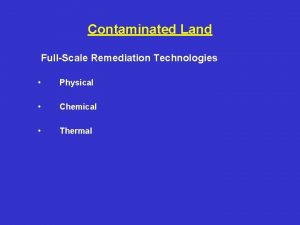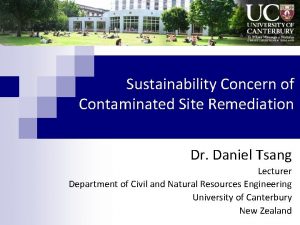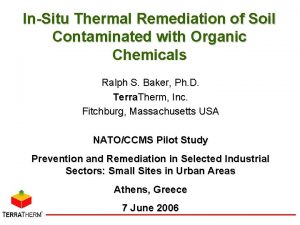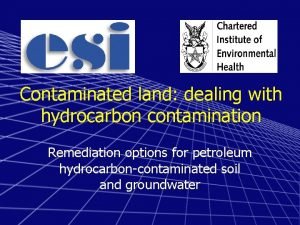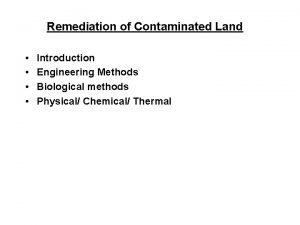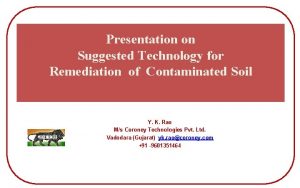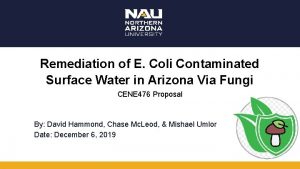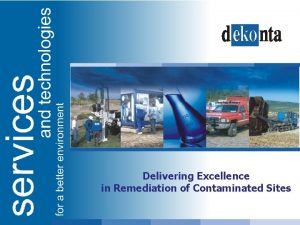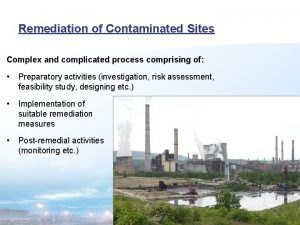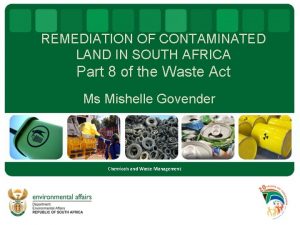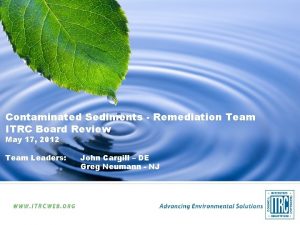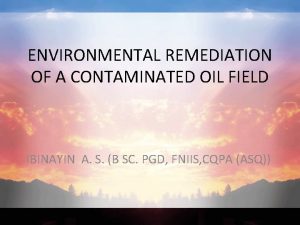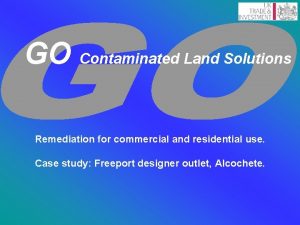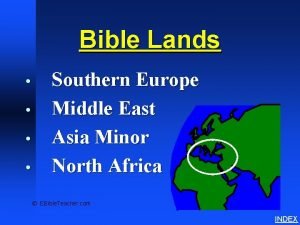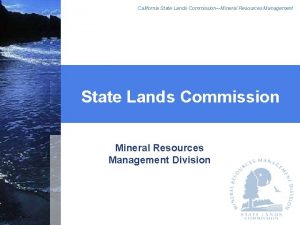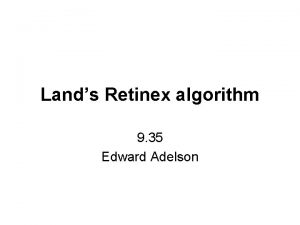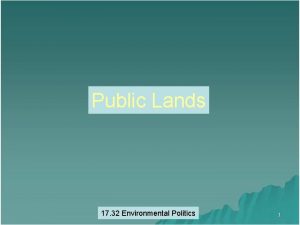Remediation of Contaminated Lands The Maralinga Lessons Geoff
















































- Slides: 48

Remediation of Contaminated Lands The Maralinga Lessons Geoff Williams ARPANSA January 2013

Background – UK Atomic Tests in Australia • Between 1952 and 1957, the UK conducted 12 atmospheric nuclear weapons tests in Australia at 3 sites. Seven of these were exploded at Maralinga in 1956 and 1957, ranging in size from 1 to 25 k. T. • As well, over 600 ‘minor trials’ dispersed long-lived radioactivity to the local environment: – Natural and depleted U. – Plutonium (24 kg) and americium. • Maralinga is a former military nuclear test site now under civilian control. 2

Background – UK Atomic Test Sites in Australia 3

Background – Source of the Problem • The 12 major trials left close-in contamination (fallout and neutron activation products) but no long-term hazard. – By 2030, the most contaminated site of a major atomic test at Maralinga will have decayed to levels acceptable for permanent occupancy. Contamination ≤ 30 y half-life allows option of doing little while waiting for decay – institutional control feasible. – If all the British had done was detonate 12 atomic bombs in outback Australia, there would have been no need for a $100 M+ clean-up. • BUT the 100 s of minor trials dispersed highly radioactive and long-lived contamination to the local environment, which was then ploughed by the British to reduce its concentration by dispersal. – Ranged in size from inhalable dust to collectible fragments. 4

Friable Uranium 5

Background – Cleaning up the Mess • 1964: Maralinga range activities suspended and range ‘cleaned-up’ pending a final decision about future use. • 1967: Operation Brumby – major ‘final’ UK/Aust clean-up; Australia accepts UK assurances about state of Maralinga Range and relieves UK of further responsibility about test sites. Contaminated areas ‘ploughed’. • Worst contamination close to firing pads at Taranaki was bulldozed into shallow pits, quantities unknown. • 1979: Repatriation of 0. 4 kg Pu in discrete package from burial pit to UK. 6

Background – Remaining Contamination • In Operation Brumby (1967), the surface soil in the central area at Taranaki was treated by mixing to reduce average contamination levels, and plume areas were ploughed. • Beyond the ploughed area the plutonium contamination tended, some 30 years later, to be on the surface. Within 500 m of the 12 firing pads there were still many thousands of contaminated fragments large enough to attract attention as potential souvenirs. • The range of types of fragments included wire, rusty steel plate, lead, pieces of a grey metal alloy of low density, bitumen and yellow bakelite. 7

Background – The Regulatory Regime in 1984 • During the period of the discovery of the remaining legacy problem, and over the course of the clean-up, there was no formal Commonwealth regulator. • The Australian Radiation Laboratory (ARL) was the Commonwealth body with responsibility for radiation protection of the Australian people. • The Commonwealth regulator, ARPANSA, was formed in 1999 by amalgamating ARL and the Nuclear Safety Bureau (NSB) in time to certify the final outcomes of the clean-up including the burial trenches and remediated land. 8

Background – Who Did What • Manager (government dept) subcontracted out various scientific studies (ANSTO, NRPB, US EG&G) and employed various sub-contactors to manage the remediation project and to perform the engineering and earthworks. • ARL performed the roles of scientific adviser and healthphysics and soil-removal auditor for the project. – • ARL assisted with characterising the contamination, determining the health risks and advising on clean-up criteria and remediation strategies, and in auditing the efficacy of the clean-up as it proceeded. Disposal of the waste in on-site burial trenches was performed in accordance with the national Code of Practice for Near-Surface Disposal of Radioactive Waste. 9

1. Discovery of the Problem • Having accepted UK assurances, Australia had no knowledge of the problem until particles and fragments highly contaminated with uranium and plutonium/americium were discovered on and close to the surface, in large numbers over a wide area (May 1984). • The contaminated land belonged to indigenous Aborigines who wished to resume ownership and use of the land. • From the outset, the local stakeholders were fully informed of the nature of the discoveries and the impacts on them. This was critical to avoid any suspicions of cover -ups. Building trust and confidence in ARL. 10

2. The Resolve to Do Something 1. Lifestyle issues. Local Aboriginal stakeholders – desire to resume ownership and use of contaminated lands. 2. Political. Royal Commission into British Atomic Weapons Tests in Australia. 3. Radiation protection mandate of ARL – to ensure the health and safety of the Australian population with regard to exposure to ionising radiation. – Prior to the clean-up, possibility existed that an individual could be inadvertently exposed to enough plutonium to ultimately kill them. 11

3. Technical Assessments – to Characterise the Problem • Determine the nature of the hazard (external dose, inhalation, particles). • Characterise the contamination (field & lab. studies – particle size distribution, dust loadings, radionuclides present, solubilities and chemical properties). • Effects on the environment (uptake by plants & animals). • Spatial extent of the contamination (aerial and groundbased surveys). 12

4. Consultation with Stakeholders • Local population and landowners, local and national governments. • Consultation in non-technical but clearly understood language. • Lifestyle (anthropology) studies, exposure scenarios. • Expectations of local population into the future. • Feedback by stakeholders into the remediation project. • Ongoing. 13

5. Determine Clean-Up Criteria • Propose & agree appropriate and acceptable dose limits (for inhalation and external exposure). • For particles, determine a practical rationale for their clean-up. • Invite feedback and agree criteria with stakeholders. 14

Maralinga Clean-Up Criteria • The criterion for rehabilitation was that the risk of fatal cancer following uptake of contamination should not exceed 1 in 10 000 by the fiftieth year, i. e. 5 m. Sv/y. • Inhalation of plutonium was the major hazard remaining at Maralinga. • Dust raising and particle-sizing studies showed that the expected annual dose by inhalation for 100% occupancy to the critical group (Aboriginal children living a semitraditional lifestyle) does not exceed 5 m. Sv/y for soil activity below 3 k. Bq/m 2 of 241 Am. 15

Maralinga Clean-Up Criteria • By limiting occupancy factors to those typical of hunting activities in a particular location, worst-case annual doses of less than 5 m. Sv can be anticipated if the activity in the soil is below 40 k. Bq/m 2 of 241 Am. • The somewhat pragmatic agreed criteria for removal of particles and fragments were: – no particles and fragments exceeding 100 k. Bq 241 Am to remain; and – particles of >20 k. Bq 241 Am not to exceed a surface density of 1 per 10 m 2. 16

Consultation on Clean-Up Criteria • Remedial action should take account of the cost of intervention and rehabilitation against the hazard averted by the work. • 120 km 2 is contaminated to the extent that it exceeds the 5 m. Sv/y criterion for 100% occupancy. • Complete removal of vegetation and soil should be avoided because of the environmental damage. • Only the worst aspects of contamination should be treated by soil removal, the remaining 120 km 2 area to remain alienated and marked at close intervals with signs to indicate that the area is suitable for hunting but not for camping. That is, creation of a ‘non-residential area’. 17

6. Choosing a Clean-Up Strategy Options included: • Fencing the contaminated areas – Surround 120 km 2 with High Cyclone Mesh fence: cost $A 13 M • Burial of all contaminated soil – Collect 120 km 2 of soil and bury: cost $A 650 M • Something in-between • In-situ vitrification (ISV) or pressure grouting of buried debris – Remove from bioavailability all Pu-contaminated waste buried by UK in pits: cost $A 20 -30 M 18

The Adopted Clean-Up Strategy Cost $108. 8 M – Elements include: A 120 km 2 ‘Non-Residential Area’ • A non-residential area was established comprising those areas in which the expected annual dose by inhalation for 100% occupancy to the critical group (Aboriginal children living a semi-traditional lifestyle) exceeds 5 m. Sv per year. • Within the non-residential area, transitory activities such as hunting and travel are perfectly acceptable. However, routine use was discouraged by the removal of some defined tracks and by re-vegetation of some areas. Alternative routes, passing around the area, were improved to encourage their use. 19

The Adopted Clean-Up Strategy Soil- and Particle-Removal • Within the non-residential area, close to the Taranaki test site, short duration visits prior to the clean-up, particularly if they involved dust-raising and large respiratory volumes, could still have given rise to unacceptably high doses. • Moreover, the presence of highly active fragments and particles made the contamination of wounds and the deliberate collection of plutonium possible. Such hazards are difficult to quantify. • Therefore it was agreed to remove, entirely, the contaminated soil along with contaminated debris from close-in areas where 241 Am activities were >40 k. Bq/m 2 (averaged over 1 hectare). 20

The Adopted Clean-Up Strategy Soil-Removal • Areas totalling about 2. 3 km 2 were treated by removal of surface soil at Maralinga. The need to satisfy the two criteria relating to particles and fragments meant that the worst-case dose will, in fact, be lower than expected at the main Taranaki site. • With regard to dispersed activity, at Taranaki contaminated soil was removed to achieve levels less than 3 k. Bq/m 2 (averaged over one hectare). This has the virtue that should a future re-assessment dictate lower levels for the clean-up boundary, then it is unlikely that further removal of soil would be required from the area already 21 treated.

The Adopted Clean-Up Strategy Burial pits and disposal trenches • UK legacy pits at Taranaki were to have ISV treatment. In the event, half were treated by ISV and the remainder were exhumed and the contents buried on site in a purpose-built trench. • A near-surface disposal trench was constructed on the site, to dispose of the contaminated surface soil. Dimensions 140 x 200 m, depth 15 m. Minimum of 5 m of clean fill above the contaminated soil. Volume used for disposal of contaminated soil was ca. 263, 000 m 3. 22

23

7. Obtain Regulatory & Stakeholder Approvals for Remediation Strategy • Overall dose criterion (5 m. Sv/y for 100% occupancy at Maralinga). • Means of meeting this criterion (soil removal and disposal, detection and removal of particles and fragments, restrictions on land use). • Verification monitoring and sign-off of cleared areas. • Disposal options. • Health physics for protection of workforce including mechanisms for dust suppression during soil removal. 24

8. Obtain Funding • Negotiations with the British Government resulted in the UK paying £ 20 M towards clean-up. • Remainder of total cost of the remediation of $A 108. 8 M paid by the Australian government. • In addition, Australia pays Maralinga Aboriginal people $13. 5 M for alienation of land. • Compensation claims by individuals for harm due to the tests were also settled. 25

9. Determine Clean-Up Boundaries Based on agreed clean-up criteria • Soil removal boundaries determined by measuring activity concentrations of relevant radionuclides (ground aerial surveys). • Presence of particles and fragments exceeding 100 k. Bq 241 Am detected by vehicle with monitoring array and analysis software including GPS logging of locations. • Surface density of particles of >20 k. Bq 241 Am determined similarly. 26

27

28

29

30

10. Perform Clean-Up • The soil-removal areas were divided into individual Lots of 3 - 4 ha in area. • Surface soil removed by heavy-duty scrapers operated by contracted engineering company (Thiess). • Collected soil and contaminated fragments placed in excavated disposal trench. 31

32

11. Verification Monitoring • • Verification monitoring was performed on cleared Lots: – Search for, and remove if necessary by hand equipment, any highly localised pieces of contamination. – For surveying treated areas of land, high-resolution gamma-ray measurements were made on a roughly square grid of approximately 35 m spacing. – Nine adjacent points on the grid cover an area of approximately one hectare and the clearance criteria at Taranaki, for example, specify that the contamination be less than 3. 0 k. Bq/m 2 averaged over one hectare. Any remaining contaminated particles and fragments exceeding the clean-up criteria were removed before Lot was given clearance certificate by regulator. 33

12. Concluding Dose Assessment • The purpose of this comprehensive assessment was to verify that the whole Maralinga area had been rendered safe, according to agreed dose criteria, following work undertaken during the 1994 -2000 Maralinga Rehabilitation Project. • From the pre-remediation dose estimates, certain areas were found before clean-up to have inhalation dose rates that were too high to be acceptable under all but the most rigorously controlled circumstances. Following the rehabilitation by removal and burial at depth of contaminated surface soil, all areas at Maralinga were shown by the dose assessments to be well within acceptable limits for all envisaged land uses. 34

Outcomes (1) • The restriction on permanent occupancy within the ‘restricted land-use’ (non-residential) boundary can be seen as a purely precautionary measure as doses due to inhalation for permanent occupancy of all but a few areas (essentially within the untreated plumes) are well below the 1 m. Sv/y limit for members of the public. • For a semi-traditional Aboriginal lifestyle, with camp sites occupying considerable area and moving regularly, it is difficult to envisage circumstances which would lead to inhalation doses, even within most of the restricted zone, above acceptable limits. 35

Outcomes (2) • The argument for maintaining restrictions on land-use at central Taranaki is to restrict access to the sites of the new burial trenches (and thus discourage intrusion). • The restricted access also reduces the highly unpredictable (stochastic) and essentially non-assessable hazard from possible contact with any undiscovered active particles remaining in the plumes adjacent to the soil-removal areas. • Thus, at some time in the future (e. g. when the current ‘boundary’ signs decay) consideration could be given (based on the new dosimetry) to contracting the restricted area to only include the burial trenches and inner plume areas (where any remaining particles will be). 36

Outcomes (3) • The new dosimetry, based as it is on a revised kinetic and dosimetric model of the human respiratory tract, has resulted in decreases of the doses due to inhalation of plutonium and americium of the order of 75%. • As a consequence of the combined effects of the revised dosimetry and better-than-expected level of clean-up of residual contamination, the estimated inhalation dose for the worst-case 3 km 2 within the ‘restricted land-use’ zone is 3. 6 m. Sv/y and a restricted area is not strictly required to meet the regulatory objective for the inhalation pathway. 37

Outcomes (4) • It is now impossible for casual visitors making intermittent forays to the area, for example tourists, geological prospectors and surveyors, who do not engage in abnormal dust raising or large-scale soil-disturbance activities, to receive a committed effective dose by inhalation of anything approaching 1 m. Sv. • The estimated doses received during ambient (calm) conditions are very low, and exposure to the substantial dust loadings observed during times of severe dust storms also results in doses which are essentially insignificant. 38

13. Program of Ongoing Checks • Looking to the future, there a number of effects which will alter the potential doses and health risks with time. • One effect is obviously radioactive decay, although this is only significant over time-scales of millennia. Over hundreds of years, assuming the contamination stays in its present location, the dose will remain approximately the same. • Another effect which will alter potential doses is weathering. • It is likely that the plutonium is moving deeper into the soil, and not migrating off-site, leading to less inhalation dose to a potential inhabitant. 39

Ongoing Checks • Lifestyle changes could also markedly affect dose estimates. If in time the Maralinga Aborigines were to move towards a more European lifestyle, with extensive areas being covered by concrete, tarmac, buildings and lawns, and living in western-style houses in suburban settings, then the dust levels and hence doses are expected to be much lower. • Program of ongoing monitoring of relevant parameters to determine changes over time, and to assess effects on health and safety for occupants, visitors and users of the remediated areas of land. 40

Lessons Learned from Maralinga • Every remediation will be very different from the others before it. – Differences in local environment and geosocial aspects. – Site details affecting cost/benefit analysis: – • value of land; • disposal options and costs. Differences in radionuclides comprising the contamination: • affect doses and pathways; • detectability. – Different exposure pathways and clean-up criteria. – Etc, etc. 41

Lessons Learned from Maralinga (2) • At the time the contamination occurred, the land was considered worthless and uninhabitable forever. As a result, actions were taken that made future clean-up far more difficult and costly: – Indiscriminate and undocumented disposals in shallow pits. – Ploughing of surface contamination, mixing it with soil below to reduce its concentration. Forty years later, the views of society had completely changed and there was a resolve to return the land, now highly valued, to its Aboriginal owners. • Technology had advanced making clean-up more feasible. 42

Lessons Learned from Maralinga (3) • The 13 steps summarised here worked at Maralinga, and the resultant clean-up has exceeded expectations in respect of hazards removed and potential doses averted. – • Stakeholders (Maralinga Aborigines) satisfied and have resumed ownership and use of previously alienated land. Focus on fixing the possibilities for giving very high doses: – Contaminated soil was removed (preventing inhalation of Pu). – Highly active particles were removed to prevent deliberate collection of contaminated fragments and particles. – Legacy burial pits containing debris contaminated with plutonium rendered practicably inaccessible by the process of exhumation and burial at depth. 43

Lessons Learned from Maralinga (4) • Critical importance of stakeholder consultation and feedback, not just building trust and confidence, but informing the environmental outcomes of clean-up. • The need for scientific expertise – available to both the project manager and regulator – for determining clean-up criteria and strategies, and for informing regulatory decisions. • The need for excellent engineering and technical support (specialised monitoring equipment and software development). 44

Lessons Learned from Maralinga (5) • The need for efficient and effective regulatory processes: – The regulator probably can’t speed up the remediation, but can certainly slow it down. – Regulatory “nervousness” can freeze the project. – Terminology – contamination is a subset of waste, but in the Australian mind they are very different. Contamination is something to be dealt with, radioactive waste is anathema. – Role for creativity in disposal solutions for remediating existing situations – without any unacceptable reduction in safety, encourage flexibility that will hasten approvals. Such as incorporation of strong elements of reversibility and retrieval, and innovative means of information preservation – essential if long-lived contamination is disposed of in a near-surface facility. 45

Lessons Learned from Maralinga (6) • During the technical assessment phase (characterising the problem, consulting, determining clean-up criteria and strategies), benefits of cooperation between regulator and body responsible for managing the clean-up. Note: in remediation, the goal is common. – • This is especially important in an accident recovery situation where speed is of the essence. Balance the requirement for independent regulatory decisions with scientific/technical cooperation wherever possible to aid in meeting the common clean-up goals as quickly as possible. 46

Lessons Learned from Maralinga (7) • In trialing new technologies (ISV treatment of legacy burial pits in Maralinga case), be prepared with a plan to abandon the trial and move to an alternative option if necessary. • Break the remediation down into manageable bits: • – Clear and defensible dose criterion/reference level. – Practical clean-up criteria (e. g. for contaminated particles). – Average over realistic areas. – Divide the total area into tractable-sized lots and treat each lot individually. Value in keeping everything as simple as possible, with an eye on not complicating the future. 47

The End geoff. williams@arpansa. gov. au
 Definition of contaminated
Definition of contaminated Contaminated wound
Contaminated wound Contaminated product insurance
Contaminated product insurance Newsworthy event (s) background event (s) sources
Newsworthy event (s) background event (s) sources Australian contaminated land consultants association
Australian contaminated land consultants association Network access quarantine control
Network access quarantine control Sox remediation software
Sox remediation software Remediation plan in change lifecycle
Remediation plan in change lifecycle Eits nevada
Eits nevada Ckla assessment and remediation guide
Ckla assessment and remediation guide Dlp remediation
Dlp remediation Remediation of the struggling medical learner
Remediation of the struggling medical learner Bolter grusin remediation
Bolter grusin remediation Somerset mold removal
Somerset mold removal Site remediation toronto
Site remediation toronto Wcp envelope
Wcp envelope Geoff sussman wound clinic
Geoff sussman wound clinic Geoff hulten
Geoff hulten Geoff buckley
Geoff buckley Geoff huston apnic
Geoff huston apnic Geoff goldsmith
Geoff goldsmith Geoff wilson lexington ky
Geoff wilson lexington ky Kavita deepak knights
Kavita deepak knights Geoff barton headteacher
Geoff barton headteacher Geoff kleinman
Geoff kleinman Geoff parks
Geoff parks Geoff hollington
Geoff hollington Romiette and julio quotes
Romiette and julio quotes Geoff mason
Geoff mason Kavita deepak knights
Kavita deepak knights Geoff grenier
Geoff grenier Geoff petty
Geoff petty Geoff mitchell md
Geoff mitchell md Geoff layer
Geoff layer Sue cowley behaviour management
Sue cowley behaviour management Geoff squire
Geoff squire Geoff michaelson
Geoff michaelson Geoff bridgman nz
Geoff bridgman nz Geoff baines
Geoff baines Icedip model of creativity
Icedip model of creativity Geoff cundiff
Geoff cundiff Geoff snelgar
Geoff snelgar Geoff hayward
Geoff hayward Geoff savage
Geoff savage Geoff willis
Geoff willis Geoff barton dundee
Geoff barton dundee Geoff knowles
Geoff knowles Viking trade routes
Viking trade routes Acquiring new lands
Acquiring new lands
